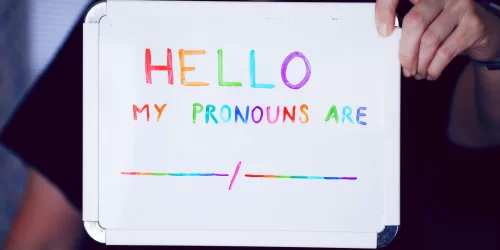
Best Practices for Faculty to Support Students in Distress or in Crisis
In this post, you will learn about best practices to support students in distress or in crisis. Some of the information here is based on More Feet on The Ground, a recommended, free, 25-minute online campus mental health training available to anyone working in post-secondary education.
Setting Students Up For Success
Especially during the COVID-19 pandemic, students face numerous challenges that negatively impact their well-being (e.g., Hamza, Ewing, Heath, & Goldstien, 2021; Mridul, Bisht, Sharma, & Kaur, 2021).
To support students proactively, you can create a positive and safe learning environment (Hamza et al., 2021).
How can you do this?
- Post the Ask For Help Guide in the eConestoga course shell so this resource is easily accessible to students
- During stressful times (e.g., midterms, exams) remind students of Student Health & Wellness resources and support
Recognizing Students in Distress or in Crisis
Faculty play a key role in recognizing signs of student distress and for early intervention to proactively support students (e.g., St-Onge & Lemyre, 2018).
What are signs that a student is in distress?
- Changes in academic behaviour and performance (e.g., repeated absences, missed assignments, deterioration in quality of work)
- High or lack of emotionality (e.g., anger or hostile outbursts, anxiety, irritability, withdrawn, animated, difficulty regulating emotions, disclosing personal problems, crying or tearfulness)
- Changes in physical well-being (e.g., fatigue, noticeable changes in appearance or hygiene, disorganized speech, frequent or chronic complaints about physical health: e.g., headaches or stomach aches)
What are signs that a student is in crisis?
- Needs an immediate response
- Involves imminent risk of safety for the student and/or others
- Examples include: self-harm, threats or acts of violence, potential substance over-use (e.g., overdose, alcohol poisoning)
For more information about a potential crisis situation, see this resource.
Responding to Students in Distress or in Crisis
What’s the best way to respond to students in distress?
Generally, it’s best to start a conversation with the student before making a potential referral.
What’s the best way to connect with a student in distress?
- In-person, over the telephone, or in an unrecorded Zoom meeting
- Avoid e-mail – fewer opportunities for real-time conversation
- Keep communications confidential (i.e., no CC’ing or BCC’ing multiple people; ensuring private information is not retrievable on shared devices/resources)
What should I say to a student in distress?
- Express genuine concern (e.g., “I wonder if we can talk about…”)
- Be specific about your observations (e.g., “I’ve noticed that…”)
- Ask open-ended questions (e.g., “what concerns do you have about…?”)
- Validate student experiences (e.g., “I understand how that might be stressful”)
- Emphasize personal control (e.g., “whatever you decide, it’s up to you”)
- Normalize help-seeking (e.g., “we all need a little help sometimes”)
- Emphasize that you can get them help (e.g., “I can let you know a bit more about what supports and services we have at Conestoga”)
What about in crisis situations?
It is important to gather key information to help a student in crisis. Ask the following questions:
- Where are you currently? What’s your address?
- What’s your phone number?
- Is someone with you? If no one is presently physically with them, ask if they can find someone in their household to be with them during this time. Ask if there is someone they can contact to come be with them at this time.
Referring Students to Services and Supports
What’s the best way to refer a student in distress?
Refer students to the Conestoga CARE Team by filling in the CARE Team Report form together, with the student present, or on behalf of the student, after they agree to seek further supports and services
Can I refer a student without the student’s knowledge or permission?
Legally this is permissible, but it could raise issues for the College or the student. It’s best to start a conversation with the student to refer them, instead of referring without the student’s permission or knowledge (see above section on responding to students).
What services and supports are best for a student in crisis?
All of the below are available 24/7:
- Campus Security Services (519-748-5220, ext. 5555) if the student lives on-campus;
- Here 24/7 Crisis support line (1-844-437-3247) if the student lives in the Cambridge, Waterloo, Kitchener, Guelph, Wellington region;
- Good2TALK (call 1-866-925-5454 or text GOOD2TALKON to 686868) if the student lives in Ontario;
- Canadian Crisis Line (call 1-833-456-4566) or Kids Help Phone (call 1-800-668-6868 or text CONNECT to 686868) if the student lives in Canada;
- International SOS Dedicated Line (+1 215-942-8478) if the student is out-of-country.
In crisis situations, it’s best to call a support with the student present (e.g., over Zoom, using your phone or the student’s phone while on speakers). If this is not possible, try to ensure a student is with someone else who can refer them before you end the phone or Zoom call.
What happens if a student chooses not to follow through on a referral?
Your offer for a referral may be rejected.
When the student is in distress:
- Try to keep lines of communication open with the student (e.g., “I’d like to hear how things are going for you. Would you feel comfortable checking back in with me?”)
- E-mail a copy of the Ask For Help Guide to the student, so they have the resources with them
- If the student continues to show signs of distress or you are concerned for the student’s well-being, faculty should submit a CARE Team report.
If this is a crisis situation:
- Contact one of the above crisis numbers immediately to notify them about the student
- After connecting with a crisis service, submit a CARE Team Report to ensure follow up and support for the student.
References
Hamza, C.A., Ewing, L., Heath, N.L., & Goldstien, A.L. (2021). When social isolation is nothing new: A longitudinal study on psychological distress during COVID-19 among university students with and without preexisting mental health concerns. Canadian Psychology, 62, 20-30.
Mridul, Bisht, B., Sharma, D., & Kaur, N. (2021). Online classes during COVID-19 pandemic: Anxiety, stress, and depression among university students. Indian Journal of Forensic Medicine & Toxicology, 15, 186-189.
St-Onge, M. & Lemyre, A. (2018). Assessing teachers’ attitudes towards students with mental health disorders in 16 post secondary institutions in Quebec. International Journal of Disability, Development, and Education, 65, 459-474.







2 Responses